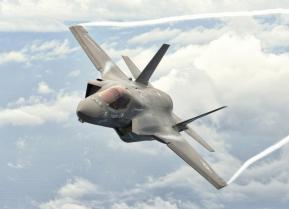The Royal Navy's New Aircraft Carrier (Armed with F-35s) Is Headed for America
The future is now.
The United Kingdom’s new aircraft carrier has set sail for North America. The four-month “Westlant 19” deployment is a glimpse into the Royal Navy’s future as it reorganizes around HMS Queen Elizabeth and her sister ship Prince of Wales.
Queen Elizabeth sailed from Portsmouth on Aug. 30, 2019 for operational trials off the U.S. and Canadian east coasts. Heading west, the 65,000-ton-displacement carrier met up with the brand-new Royal Fleet Auxiliary fast support ship Tideforce, the Type 45 destroyer HMS Dragon and the Type 23 frigate HMS Northumberland.
Also aboard: helicopters, a company of Royal Marines and a high-end medical team.
But the most important component of the trial strike group might be its fighters. Building on Queen Elizabeth’s 2018 flight trials, Westlant 19 will include five weeks of at-sea air operations involving no fewer than seven U.K. F-35B stealth fighters and pilots from No. 17(R) Test and Evaluation Squadron, No. 207 Squadron and No. 617 Squadron, the latter representing the front-line Lightning Force.
U.S. Marine Corps F-35Bs are slated to join the U.K. jets once Queen Elizabeth nears the American coast. U.S. Navy and Air Force and presumably Canadian planes and ships also will train with the U.K. strike group.
“The success of last year’s deployment during which we embarked and operated the F-35B for the very first time put us ahead of the curve in terms of developmental testing between the jets and ship,” said Commodore Mike Utley, commander of the strike group.
“We have a significant switch in focus this year, towards operationalizing this national defense capability – turning this ship, the jets for which it has been built and all supporting units into a cohesive, agile, efficient force.”
With Queen Elizabeth slated to begin deploying on front-line patrols starting in 2021, the U.K. fleet must figure out how to deploy, as a cohesive force, large numbers of warships comprising a carrier strike group.
Contrast this with the fleet’s current deployment model, which for the most part sends out single warships on solo patrols, each at their own pace.
If the reorganization succeeds, the Royal Navy will evolve from a thinly but widely spread force to one that deploys to fewer places at a time, but does so in greater concentration. The Royal Navy would become what Tony Radakin, the new first sea lord, called “a proper, carrier task group navy.”
“The whole pattern of the fleet will have to change so that a group of escort vessels and support ships are all brought to readiness together to deploy with the aircraft carriers,” the website Save the Royal Navy noted. “Changing the rhythm of deployments to this new model, while still retaining the flexibility for ships to operate independently, perhaps detaching to and from the carrier group, will be a complicated balancing act.”
The Royal Navy’s small size -- it possesses just 19 frigates and destroyers -- makes this balancing act even more complicated. A U.S. Navy carrier strike group typically deploys with one carrier, a cruiser functioning as air-defense commander plus three escorting destroyers, an attack submarines and a logistics ship. The destroyers and submarine can detach for solo patrols.
As only one-third of warship are available for operations at any given time, in the Royal Navy a single carrier strike group easily could account for half the deployable frigates and destroyers.
Fleet planners are working on one possible solution. “Limited escort numbers offer limited choices but the [Royal Navy] is moving towards a new manning model which may get more from the same number of hulls,” Save the Royal Navy explained.
From the Royal Navy:
HMS Montrose’s permanent deployment in Bahrain with her crew rotating about every four months is effectively a trial to see if this is workable. More forward-basing could be adopted with another vessel permanently based in Singapore as an option under consideration.
Crew rotation for ships on long deployments is also a possibility. There are great efficiencies to this system as it saves long transits to and from the U.K. and extends the time a ship can be deployed in a particular region. It may also help retention as sailors are away for shorter and more predictable periods.
David Axe serves as Defense Editor of the National Interest. He is the author of the graphic novels War Fix, War Is Boring and Machete Squad.


